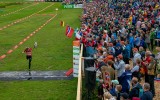This year troops from many countries will be fighting for medals in the woods near Spydeberg. Not far from the WOC venue at Mørk two bloody wars have taken place during the last two centuries.
Østfold has experienced its fair share of war throughout history. Most well-known is probably the shooting of the Swedish king Carl XII at Fredriksten fortress in 1718.
The Glomma Line
The Glomma River has been a natural barrier during several wars. The river is the longest in Norway and splits Østfold county into two halves. Spydeberg is situated on the west side of the river with important highways and railways crossing the river on the way east.
Twice during the 19th and 20th centuries real wars have hit Spydeberg.
Swedish attack
As a part of the European shake-up during the Napoleonic wars, the Treaty of Kiel forced Denmark to cede Norway to Sweden in early 1814. However, led by Prince Christian Frederik the Norwegians declared their independence and adopted their own constitution at Eidsvoll on 17 May 1814.
During the summer of 1814 the Swedes wanted their bounty. Commander and Crown Prince Carl Johan had a strong desire to conquer Norway. Østfold was attacked from several angles and the war also rolled into the county’s inner rural districts where many men fell, Norwegians as well as Swedes. However, it was the Swedes who were on the offensive.
During a few dramatic days in August 1814 the Norwegian head quarters were located at the Spydeberg rectory. At Langnes on the other side of the Glomma River, the Norwegian forces had a sconce to stop the Swedes from crossing Glomma over a pontoon bridge that had been built here. On 9 August the battle of Langnes took place.
From his base in Spydeberg, then Norwegian king Christian Frederik was woken by the sound of shots fired a few miles away. When he saw a dead lieutenant during a visit to the front the king burst out: ”My God, is all this my fault?”

PHOTO: A depiction of the battle of Langnes on 9 August 1814 between Norwegian and Swedish forces. Illustration: H. A. Angrell / Nasjonalbiblioteket.
Buried in Spydeberg
Despite fighting well, the Norwegian king decided to withdraw in order to stop the war. The Norwegians withdrew back across the Glomma into Spydeberg; they had lost six or seven men. Another 20 soldiers died from dysentery at a field hospital in Spydeberg.
Already on 8 August the Norwegian State Council met at the rectory in Spydeberg. The Norwegian leadership accepted a surprising Swedish offer to cease hostilities. Norway’s position was hopeless against the overwhelming Swedish power. The war was over in two weeks. After peace negotiations in Moss, Norway had to accept a union with Sweden but at the same time Norwegian independence was recognised.
War came by bus
126 years later the enemy came from the opposite direction. Thursday 11 April 1940 German forces who had just arrived in Oslo were ordered to march directly to Østfold. Around 1500 men marched through Hobøl and Spydeberg in order to confront what the German attackers thought were a Norwegian army of perhaps 4000-5000 men.
The World War II battle of Østfold was fought at Fossum Bridge on the border between Spydeberg and Askim. At dawn on 12 April the first German soldiers arrived at Fossum in buses that had been requisitioned in Oslo. The buses were stopped by Norwegian roadblocks – and then fire broke loose against the German convoy. Most of the Germans in the first bus died. The enemy was stuck in Spydeberg.
The Norwegians attempted to blow up the Fossum Bridge, but did not succeed. Germans who tried to cross the Glomma on the ice were flushed away by water when the floodgates were opened up stream at Solbergfoss power station – or they were shot after.
Forced to give up
However, the Norwegian resistance was short-lived at this point. During the early hours of 13 April the first Germans made it across the river after a powerful attack. Later the same day there was fighting at several locations around Askim. Air support helped the German intruders in taking control. The Norwegian resistance dissolved and large parts of the Norwegian forces fled to Sweden.
On Monday 15 April 1940 German forces controlled the entire Østfold county. More than 20 soldiers and 12 civilians lost their lives during the war in inner Østfold.
Sources:
Nils E. Øy (red.), Østfold – by og bygd i Norge, Oslo, 1978.
Sven G. Eliassen, Små len – ett amt - Østfolds historie, bind 3, 2005.
Åsmund Svendsen, Fylke i grenseland – Østfolds historie, bind 4, 2005.
https://lokalhistoriewiki.no/Slaget_ved_Langnes_skanse
http://spydeberghistorien.blogspot.com/p/spydeberg-i-krig.html



